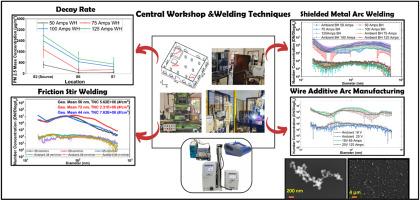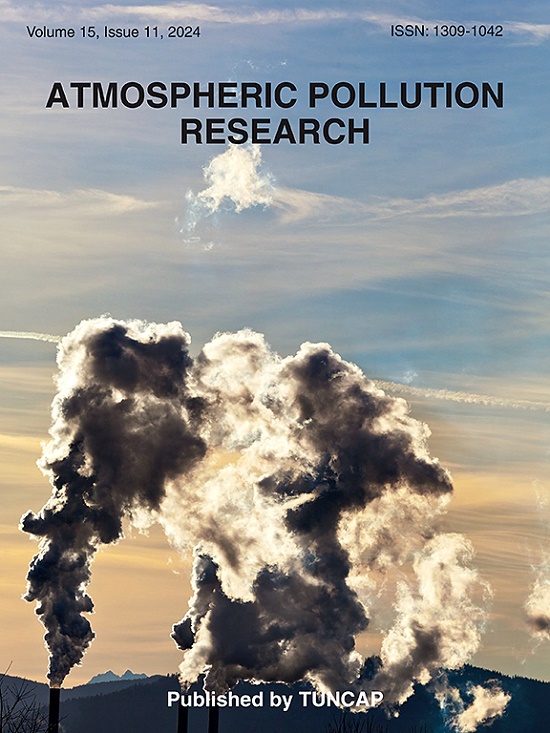Comprehensive analysis of the fine and ultrafine particulate emissions from various welding sources in an industrial environment
IF 3.5
3区 环境科学与生态学
Q2 ENVIRONMENTAL SCIENCES
引用次数: 0
Abstract
Industrial welding activities are responsible for ultrafine and fine particulate matter (PM) emissions, with established exposure-response functions for multiple health risks and premature mortality globally. This study examines the evolution of fine and ultrafine particle (UFP) concentrations from different welding techniques and their dispersion within a central workshop facility. Measurements were carried out using calibrated low-cost PM sensors (LCS), DustTrak8433, and Scanning-Mobility-Particle-Sizer (SMPS) at different heights for three welding processes: shielded metal arc welding (SMAW), wire arc additive manufacturing (WAAM), and friction stir welding (FSW). The relationship between welding conditions and PM emissions was investigated by various welding parameters, including current, voltage, and feed rate. In SMAW, the higher current intensity increased heat, electrode breakdown, and raised emissions of coarser UFP (300–550 nm) and PM2.5 at breathing height. PM2.5 emissions increased by 158 % near the source for SMAW at 125 Amperes (A) current compared to 50 A. At 2 m, 5 m, and 9 m distances, PM2.5 levels dropped to 880 μg/m3, 570 μg/m3, and 540 μg/m3, respectively, relative to source emissions at 125 A (2880 μg/m3). Post-welding, PM2.5 concentrations stabilized after 50 A at 12 min, 75 A at 34 min,100 A at 49 min, and 125 A at 63 min. For WAAM operations, PM2.5 and UFP levels peaked at low currents-voltage (globular-transfer) and reduced at high currents-voltage (spray-transfer). FSW results show that high or low feed rates combined with low or high RPMs increase UFP emissions, while a moderate feed rate (58 mm/min) minimizes emissions at any RPM. SMAW resulted in up to 68 % higher PM2.5 intake, whereas WAAM caused up to 74 % higher UFP exposure, highlighting distinct health risks across techniques. This contribution poses possible health risks due to the elevated concentrations of UFPs with varying size distributions across different welding methods.

综合分析工业环境中各种焊接源的细颗粒物和超细颗粒物排放
工业焊接活动是造成超细和细颗粒物(PM)排放的原因,在全球范围内具有多种健康风险和过早死亡的既定暴露反应函数。本研究考察了不同焊接技术的细颗粒和超细颗粒(UFP)浓度的演变及其在中央车间设施内的分散。使用校准的低成本PM传感器(LCS)、DustTrak8433和扫描-迁移-粒度仪(SMPS)在不同高度对三种焊接工艺进行了测量:屏蔽金属电弧焊(SMAW)、丝弧增材制造(WAAM)和搅拌摩擦焊(FSW)。通过不同的焊接参数,包括电流、电压和进给速率,研究了焊接条件与PM排放的关系。在SMAW中,较高的电流强度增加了热量,电极击穿,并增加了呼吸高度的粗UFP (300-550 nm)和PM2.5的排放。在125安培(A)电流下,SMAW源附近的PM2.5排放量比50 A增加了158%。在距离2 m、5 m和9 m处,PM2.5浓度分别降至880 μg/m3、570 μg/m3和540 μg/m3,相对于125 A源排放(2880 μg/m3)。焊接后,PM2.5浓度在50a(12分钟)、75a(34分钟)、100a(49分钟)和125a(63分钟)后稳定下来。对于WAAM操作,PM2.5和UFP水平在低电流-电压(球形转移)时达到峰值,在高电流-电压(喷雾转移)时下降。FSW结果表明,高或低进给量加上低或高转速都会增加UFP排放,而中等进给量(58 mm/min)在任何转速下都能将排放降至最低。SMAW导致PM2.5摄入量增加68%,而WAAM导致UFP暴露增加74%,突出了不同技术的不同健康风险。由于不同焊接方法中不同尺寸分布的ufp浓度升高,这种贡献可能造成健康风险。
本文章由计算机程序翻译,如有差异,请以英文原文为准。
求助全文
约1分钟内获得全文
求助全文
来源期刊

Atmospheric Pollution Research
ENVIRONMENTAL SCIENCES-
CiteScore
8.30
自引率
6.70%
发文量
256
审稿时长
36 days
期刊介绍:
Atmospheric Pollution Research (APR) is an international journal designed for the publication of articles on air pollution. Papers should present novel experimental results, theory and modeling of air pollution on local, regional, or global scales. Areas covered are research on inorganic, organic, and persistent organic air pollutants, air quality monitoring, air quality management, atmospheric dispersion and transport, air-surface (soil, water, and vegetation) exchange of pollutants, dry and wet deposition, indoor air quality, exposure assessment, health effects, satellite measurements, natural emissions, atmospheric chemistry, greenhouse gases, and effects on climate change.
 求助内容:
求助内容: 应助结果提醒方式:
应助结果提醒方式:


